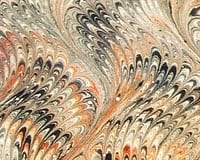Suminagashi is the ancient Japanese technique of painting on water to create marbleized effects on paper.
Literally, it means “ink-floating”, which is in reference to the Sumi-e inks that were originally used in the technique.
The patterns are the result of color floated on either plain water or a viscous solution, and then carefully transferred to an absorbent surface, such as paper or fabric.
Now, artists use both traditional inks and acrylic paints (usually watered down) to create this beautiful artwork.
What do you think of this technique? Have you ever tried it? Please share your opinion in the comments.
The above image is representative of what most people think of when they think of suminagashi.
Some of you might remember learning a basic form of this technique in a high school or college-level art class. Because it’s a relatively inexpensive in terms of materials, it’s a popular project. And the end result is almost always beautiful, as long as the inks don’t get mixed together.
Some artists have taken the technique beyond a general marbling effect to create more concrete images. Though these are often still quite abstract, they have a more defined form than basic marbling. The end result, once transferred to paper, is quite beautiful.
Here’s a video that illustrates the technique:
You can see in the video above that the technique requires a steady hand, both in applying the ink or paint to the water, and then in placing the paper on the surface to pick up the ink.
The success of the technique also depends heavily on a grasp of fluid dynamics, in addition to basic artistic ability. The artistic side of things takes on more importance depending on the complexity of the image being painted.
Popular subjects for these types of paintings include natural elements like mountains, clouds, and landscapes.
The technique originated in China over 2,000 years ago, but was practiced by Shinto priests in Japan starting in the 12th century. The basic technique remains largely unchanged, despite more modern tools sometimes being used.
One difference you’ll notice between the video and the traditional technique is that in the traditional technique, the pigments were blown across the water to form shapes and swirls, while in the video, a tool is used to manipulate the pigment across the surface of the water.
Here’s another great video that shows the process:
There are also plenty of videos available on YouTube that can show you the basic techniques used in Suminagashi. Just search for Suminagashi or painting on water to find them.
Have you ever experimented with this technique? Share your experiences and thoughts below…
